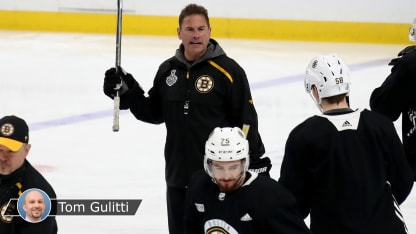The Bruins felt similarly after going 2-for-10 on the power play in the first two games of the Cup Final with each of the goals coming off zone-entry/rush plays. They used the two-day break before Game 3 to review video and work in practice on taking advantage of whatever openings the Blues were giving them.
Seeing that the Blues were concentrating on taking away their plays down low, the Bruins switched their approach to run the power play more through Krug, who plays the point in their 1-3-1 alignment. In Game 3, Boston scored four power-play goals on four shots with Krug getting the primary assist on three and scoring the other.
"I think once you get a couple of games under your belt and we've had a lot of reps, Bruce does a great job of giving us cues that if this player does this, this is the option we're going to have and the opportunity we're going to have to score a goal," Krug said.
The importance of the Bruins power play has been magnified in the Cup Final because they've struggled at times at even strength. Of Boston's 15 goals in the series, six have come 5-on-5. St. Louis has scored nine of its 11 goals in the series 5-on-5.
The Bruins top line of Brad Marchand, Patrice Bergeron and David Pastrnak has yet to produce a 5-on-5 goal in the series, but Bergeron and Pastrnak have each scored on the power play. Bergeron leads the playoffs with seven power-play goals.
"One of the ways you get going offensively is to finish your chances and get going on the power play," Cassidy said. "We talked about that. Most skilled guys, if they feel the puck on the power play, things start to happen. It bleeds into 5-on-5."
When things aren't going well on the power play, Cassidy usually goes to Krug first to ask what he's seeing from the point. A former defenseman who played 36 NHL games with the Chicago Blackhawks over six seasons from 1983-90, Cassidy can relate well with Krug, but he also values the opinions of the forwards on the power play.

